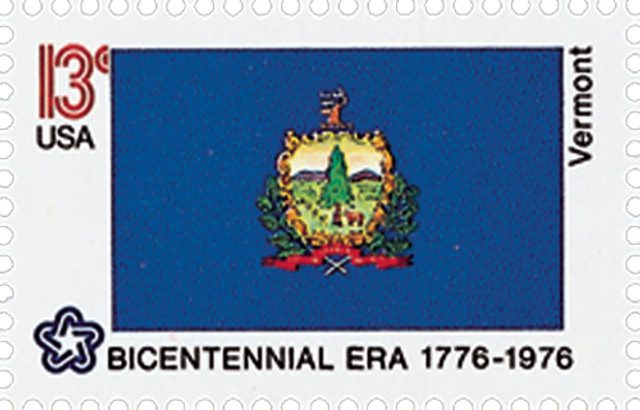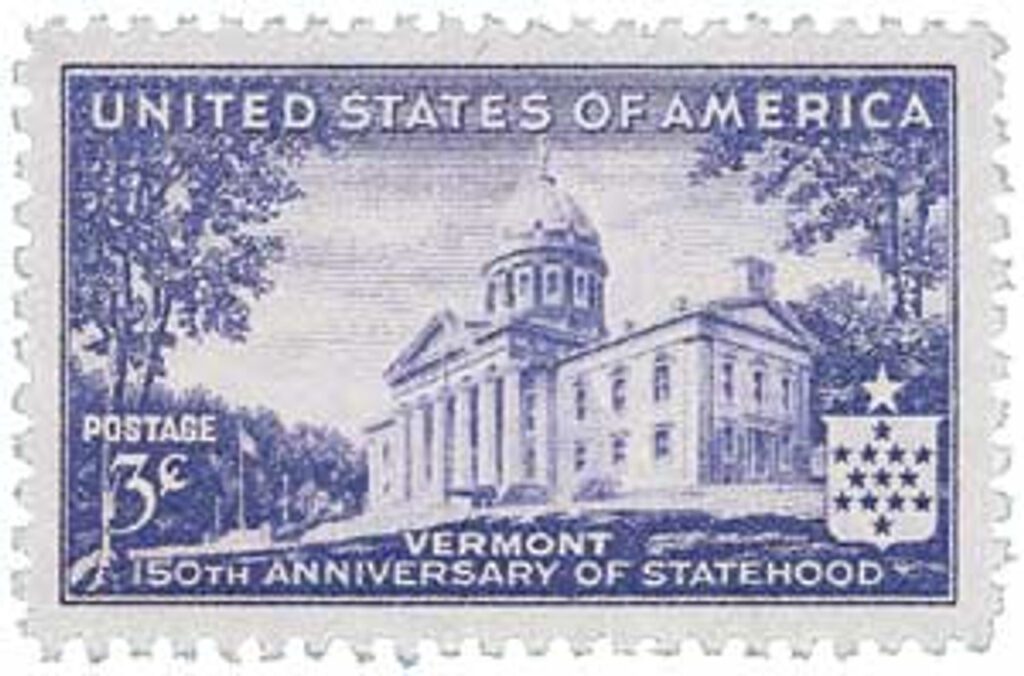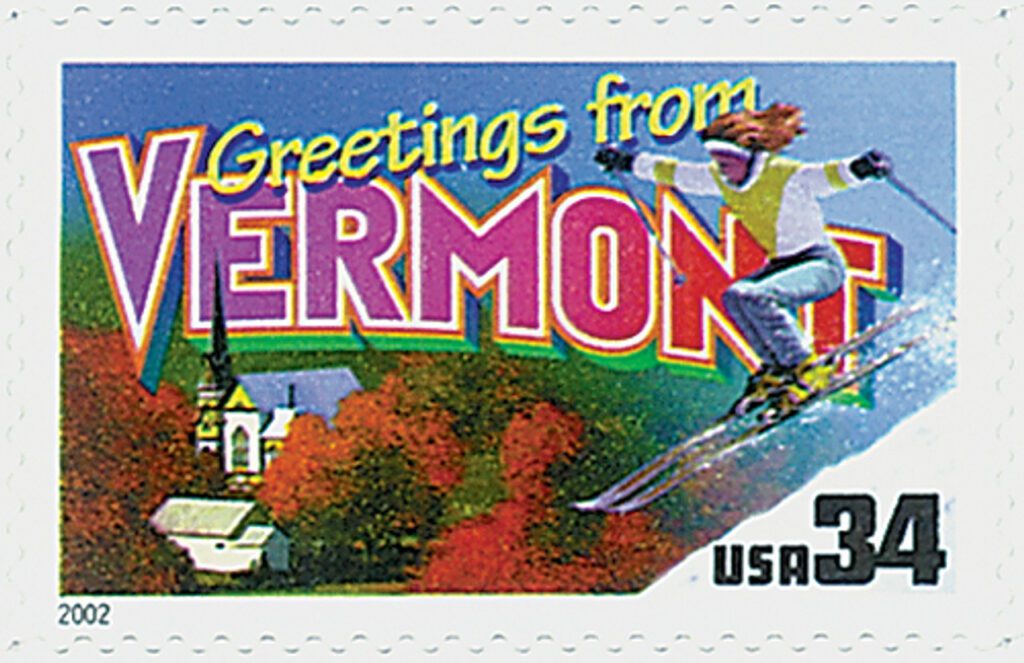On March 4, 1791, Vermont was admitted to the Union.
Vermont served mainly as a hunting ground for the tribes of Algonquian Indians before white settlement. France’s Samuel de Champlain was one of the first Europeans to explore the Vermont area. He reached Lake Champlain, which bears his name, in 1609.
Champlain claimed all of the area that is Vermont for France. In 1666, the French built a fort on Isle La Motte in Lake Champlain. The English built a fort at Chimney Point, west of today’s Middlebury, in 1690. However, the first permanent settlement was Fort Dummer, which is near today’s Brattleboro, and was built by colonists from Massachusetts in 1724. This fort was needed to protect western Massachusetts from attacks by the French and Indians. Vermont was a battleground during the French and Indian War (1754-1763). The war resulted in England’s control of most of North America, including Vermont.
The royal governors of New Hampshire and New York both made land grants to settlers in the Vermont area. Unfortunately, their claims often overlapped. In 1764, England ruled that the claims made by New York were legitimate, and ordered settlers with New Hampshire grants either to pay New York or leave. This resulted in the formation of the Green Mountain Boys, a military force organized to protect land claims granted by New Hampshire. The Green Mountain Boys drove the New York settlers from Vermont.
Vermont provided many soldiers in the fight against the British during the American Revolution (1775-1783). In May 1775, Ethan Allen, Benedict Arnold, and a force of more than 80 Green Mountain Boys took Fort Ticonderoga from the British, which was located in New York on Lake Champlain. Colonial troops held the fort until 1777. When the patriots were driven from the fort, the British pursued. A rear guard action commanded by Seth Warner delayed the British long enough for the patriots to escape. Although the Battle of Bennington, fought on August 16, 1777, is associated with Vermont, it took place in New York. The Battle of Bennington and the surrender at Yorktown ended British occupation of the northern colonies.

As the Revolutionary War continued, the land disputes involving Vermont, New York, and New Hampshire remained unresolved. On January 15, 1777, Vermont settlers declared the area an independent republic named New Connecticut. In July 1777, Vermont adopted its first constitution and took its present name, which is taken from the French vert mont, or “green mountain.” In 1783, George Washington wrote that he believed it would take force to end Vermont’s independence. However, no efforts were ever made to do so.
In 1790, Vermont paid New York $30,000 to resolve its land claims and New Hampshire relinquished its claims in Vermont. As a result, Vermont joined the Union on March 4, 1791, and was the first state admitted to the Union after the 13 original colonies.
Vermonters fought the British during the War of 1812 in the battles of Chippewa, Lundy’s Lane, and Plattsburgh. Yet, the war was very unpopular in Vermont, as the state depended on trade with the British colony of Canada. The end of the war marked the start of a period of economic decline. In fact, when the economy revived from 1823-36, many people left the state, afraid that recession would return. These people moved to better farmland in the Midwest or took factory jobs in cities in other states.
The completion of the Champlain Canal in 1823 allowed the state’s farmers to find markets for their products. The canal linked Lake Champlain with and New York’s Hudson River. This meant farm products could be sent quickly to New York City. The market for wool was especially lucrative. By 1840, Vermont had six sheep for every person in the state. Soon after, competition from Midwestern farmers caused wool prices to drop. Vermont farmers sold their sheep for meat, and by 1860, the sheep population had been cut in half. This crisis forced Vermont to become a dairy-farming state. Farming became even less profitable after the Civil War. Large numbers of farmers left the state for factory work or to claim land in the Midwest. However, French Canadians and European immigrants continued to move to Vermont’s cities. During the late 1800s, Vermont’s wood-processing and cheese-making industries began to flourish.
Discover what else happened on This Day in History.






Read more of the history of the area than was ever taught in school – ‘back in the day’ – amazing that there was this much conflict and such in the area – never would have known. Always had athe idea that the area was so peaceful. Ha! Thanks for the historical snapshot.
Great Summary!
I like this program this day history
Mystic provides one of the best sources of information and/history. KEEP UP THIS GOOD WORK
As always a very interesting history of a state. Would be nice to add facts about Vermont in the 20th century.
Good article. I have my father’s bible. The frontispiece has his handwriting with his name and the note ” TroopJ 2nd U. S. Cav, Fort Ethan Allen, Vermont” . He met my mother in Plattsburg and they were married in 1916. Interesting reading about Vermont. Thanks.
I find every one of the “This Day in History to be very information and look forward to reading them. I have learned much about our nation that is not taught in history classes. Thank you
Surprised that they left out how the battle of Bennington contributed to the American victory at Saratoga that in turn lead to France entering the American Revolution that in turn led to Yorktown. Good to use any opportunity to tie historic events together.
“The Battle of Bennington and the surrender at Yorktown ended British occupation of the northern colonies.” Yorktown? I think you mean Saratoga.
I had wondered why Vermont was not one of the original colonies considering its proximity. So in essence it was but not as an entity. Great information Mystic and not the first mention of maple syrup.
Nice article from Vermont glad to read about our state.
March 4 used to be the date of the inauguration of Presidents from Washington to F.D. Roosevelt. That would have made a good topic for today as well. Nice that you all always highlight the settlement of white Americans and dismiss Native Americans as the losers only. Give their history a bit of light sometimes. They were the originals in residence.
I was stationed at Plattsburg AFB, a short ferry ride from Vermont and central to today’s article. I learned more in this short article than I ever learned in the 3 years I lived there. Good work, Mystic.
Wonderful article! My great aunt in Bennington would be pleased.